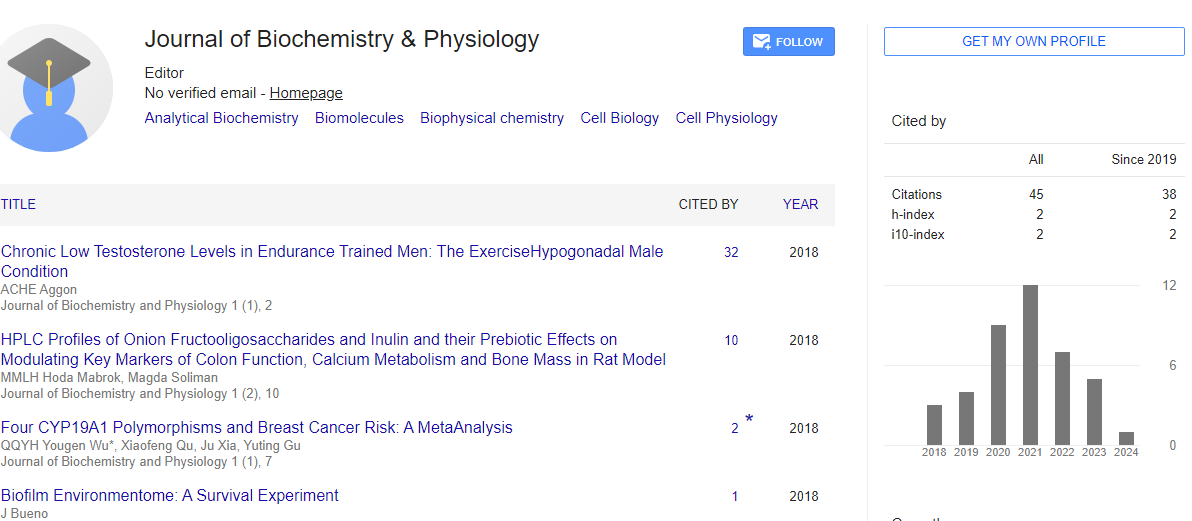Commentary, J Biochem Physiol Vol: 7 Issue: 1
Role of Clinical Biochemistry in Infectious Disease Diagnosis and Surveillance: Insights from Molecular Diagnostics
Ida Van*
1Department of Clinical Biochemistry, PathWest Laboratory Medicine-Royal Perth Hospital, Perth, WA, Australia
*Corresponding Author: Ida Van,
Department of Clinical Biochemistry, PathWest
Laboratory Medicine-Royal Perth Hospital, Perth, WA, Australia
E-mail: vanid@va.edu
Received date: 19 February, 2024, Manuscript No. JBPY-24-134958;
Editor assigned date: 21 February, 2024, PreQC No. JBPY-24-134958 (PQ);
Reviewed date: 11 March, 2024, QC No. JBPY-24-134958;
Revised date: 20 March, 2024, Manuscript No. JBPY-24-134958 (R);
Published date: 29 March, 2024, DOI:10.4172/jbpy.1000157.
Citation: Van I (2024) Role of Clinical Biochemistry in Infectious Disease Diagnosis and Surveillance: Insights from Molecular Diagnostics. J Biochem
Physiol 7:1.
Description
Infectious diseases pose significant threats to public health worldwide, necessitating accurate and timely diagnostic methods for effective disease management and surveillance. Clinical biochemistry, particularly molecular diagnostics, plays a crucial role in the detection, characterization, and monitoring of infectious agents. This article explores the pivotal role of clinical biochemistry in infectious disease diagnosis and surveillance, focusing on the insights provided by molecular diagnostic techniques.
Molecular diagnostics involve the detection and characterization of nucleic acids, such as DNA and RNA, from infectious agents using techniques Like Polymerase Chain Reaction (PCR), Nucleic Acid Amplification Tests (NAATs), and Next-Generation Sequencing (NGS). These methods offer unparalleled sensitivity and specificity, enabling the rapid and accurate identification of pathogens, including bacteria, viruses, fungi, and parasites. Molecular diagnostics have revolutionized infectious disease diagnosis by providing rapid results, facilitating early treatment initiation, and guiding infection control measures.
Molecular diagnostics allow for the precise identification and characterization of infectious agents, including the differentiation of pathogen strains and subtypes. By targeting specific genetic markers or conserved regions of the pathogen genome, molecular assays can distinguish between closely related species or strains with distinct virulence properties. This information is invaluable for tracking the spread of infectious diseases, investigating outbreaks, and implementing targeted interventions to control transmission.
Antimicrobial Resistance (AMR) poses a major challenge to infectious disease management, necessitating accurate and timely Antimicrobial Susceptibility Testing (AST). Molecular methods, such as PCR-based assays and Whole-Genome Sequencing (WGS), can rapidly detect known resistance genes or mutations associated with antimicrobial resistance. These tests provide clinicians with critical information for selecting appropriate antimicrobial therapy and optimizing patient outcomes while minimizing the spread of resistant pathogens.
Molecular diagnostics play a vital role in the surveillance of emerging infectious diseases and the early detection of novel pathogens with pandemic potential. By monitoring the genetic diversity and evolution of infectious agents, molecular surveillance systems can detect emerging strains, track their spread across geographical regions, and assess their impact on public health. Realtime genomic surveillance platforms enable rapid data sharing and collaboration among researchers and public health agencies, facilitating proactive response efforts to emerging threats.
Advances in molecular diagnostics have led to the development of Point-of-Care (POC) testing platforms that enable rapid and decentralized testing in clinical settings, remote areas, and resourcelimited settings. POC molecular tests, such as nucleic acid amplification assays and Loop-Mediated Isothermal Amplification (LAMP) assays, provide actionable results within minutes to hours, allowing for timely patient management decisions, infection control measures, and outbreak containment strategies.
Despite the numerous advantages of molecular diagnostics in infectious disease diagnosis and surveillance, several challenges remain, including cost, technical complexity, and accessibility, particularly in resource-limited settings. Addressing these challenges will require continued investment in technology development, capacity building, and global collaboration to ensure equitable access to high-quality diagnostic services. Future directions in molecular diagnostics include the integration of multi-pathogen panels, the development of novel biomarkers, and the implementation of artificial intelligence algorithms for data analysis and interpretation.
Conclusion
Clinical biochemistry, through molecular diagnostics, plays a pivotal role in infectious disease diagnosis and surveillance by providing rapid, sensitive, and specific methods for pathogen detection, antimicrobial resistance testing, and surveillance of emerging threats. Molecular diagnostics enable early detection of infectious agents, characterization of pathogen strains, and monitoring of antimicrobial resistance patterns, guiding clinical management decisions and public health interventions. Continued innovation and collaboration in molecular diagnostics will enhance our ability to combat infectious diseases and mitigate their impact on global health.
 Spanish
Spanish  Chinese
Chinese  Russian
Russian  German
German  French
French  Japanese
Japanese  Portuguese
Portuguese  Hindi
Hindi 